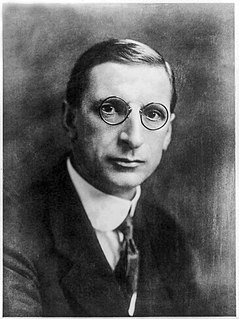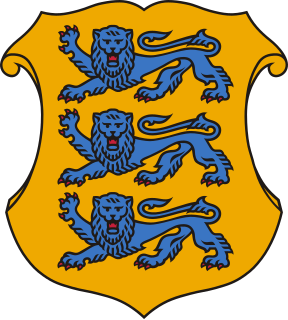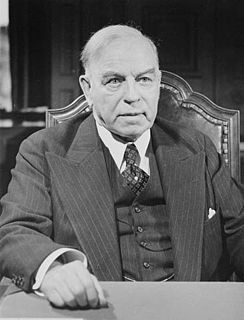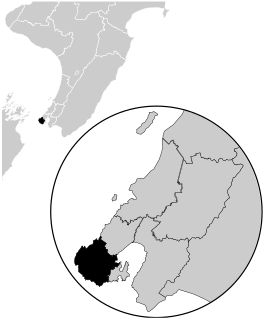
The Irish presidential election of 1959 was held on 17 June 1959. Éamon de Valera, then Taoiseach, was elected as president of Ireland. A referendum proposed by de Valera to replace the electoral system of proportional representation by means of the single transferable vote with first-past-the-post voting which was held on the same day was defeated by 48.2% to 52.8%.

Narva is the third largest city in Estonia. It is located at the eastern extreme point of Estonia, at the Russian border, on the Narva River which drains Lake Peipus.

The Riigikogu is the unicameral parliament of Estonia. All important state-related questions pass through the Riigikogu. In addition to approving legislation, the Riigikogu appoints high officials, including the Prime Minister and Chief Justice of the Supreme Court, and elects the President. The Riigikogu also ratifies significant foreign treaties that impose military and proprietary obligations, bring about changes in law, etc.; approves the budget presented by the government as law and monitors the executive power.

The New Zealand general election of 1925 was held 4 November to elect a total of 80 MPs to the 22nd session of the New Zealand Parliament. A total number of 678,877 (90.02%) voters turned out to vote. In one seat there was only one candidate.

The 15th Canadian Parliament was in session from January 7, 1926, until July 2, 1926. The membership was set by the 1925 federal election on October 29, 1925, and it changed only somewhat due to resignations and by-elections until it was dissolved prior to the 1926 election.

Parliamentary elections were held in Estonia between 21 and 23 May 1932.
Parliamentary elections were held in Estonia between 11 and 13 May 1929.

Parliamentary elections were held in Estonia between 5 and 7 May 1923. There were some controversies - some lists, most remarkably Communist, were declared void before the elections because of electoral law violations, and the results gave Estonia its most fragmented parliament ever.

Parliamentary elections were held in Estonia between 27 and 29 November 1920, the first held under the 1920 constitution. 100 deputies were elected into the new Riigikogu by party lists in 10 regions, by which one party or electoral bloc could put up several lists in one region. Seats were still distributed on the state level, where votes for different lists were summed up by their political affiliation and then seats distributed using d'Hondt formula. Thereafter seats for one party or bloc were distributed between different lists of that political force using the same formula.

The Estonian Swedes, Estonia-Swedes, or Coastal Swedes are a Swedish-speaking minority traditionally residing in the coastal areas and islands of what is now western and northern Estonia. The beginning of the continuous settlement of Estonian Swedes in these areas dates back to the 13th and 14th centuries, when their Swedish-speaking ancestors arrived in Estonia from what is now Sweden and Finland. Almost all of Estonia's Swedish-speaking minority fled to Sweden during World War II, and only the descendants of a few individuals who stayed behind are permanently resident in Estonia today.

Wellington Central is an electorate, represented by a Member of Parliament in the New Zealand House of Representatives. Its MP since November 2008 has been Labour Party's Grant Robertson.

Pakri Islands are two Estonian islands in the Finnish Gulf: Suur-Pakri and Väike-Pakri. Administratively they belong to the town of Paldiski. For centuries the islands had been inhabited by Estonian Swedes, until during the Second World War the entire population was forced to leave.
Cochrane was a provincial electoral district in southern Alberta, Canada. The district was mandated to return a single member to the Legislative Assembly of Alberta from 1909 to 1926 under the First Past the Post voting system and under Single Transferable Vote from 1926 to 1940.

Tarmo Kõuts is an Estonian politician and former Commander of the Estonian Defence Forces.
Voika is a village in Nõo Parish, Tartu County in eastern Estonia.
Geir André Herrem is a Norwegian footballer who plays for Bodø/Glimt.

Esimene Eesti Põlevkivitööstus was an oil shale company located in Kohtla-Järve, Estonia. It was a predecessor of Viru Keemia Grupp, a shale oil extraction company.
The Estonian Riigikogu, or Parliament, is made up of 101 members, elected from 12 separate geographic areas, or electoral districts. The constituency division is based on the counties of Estonia, of which some are combined or divided depending on the size of the population. The capital city Tallinn is divided into three electoral districts based on administrative districts within the city. In the elections to the European Parliament, Estonia has only one national electoral district.

Vassili Grigorjev was a Russian-Estonian farmer and politician.

Parliamentary elections will be held in Estonia on 5 March 2023 to elect all 101 members of the Riigikogu.













